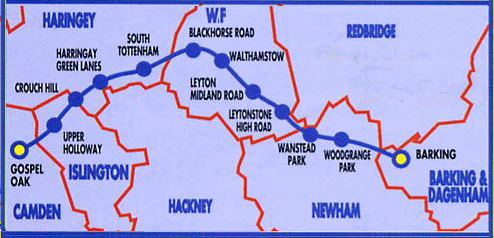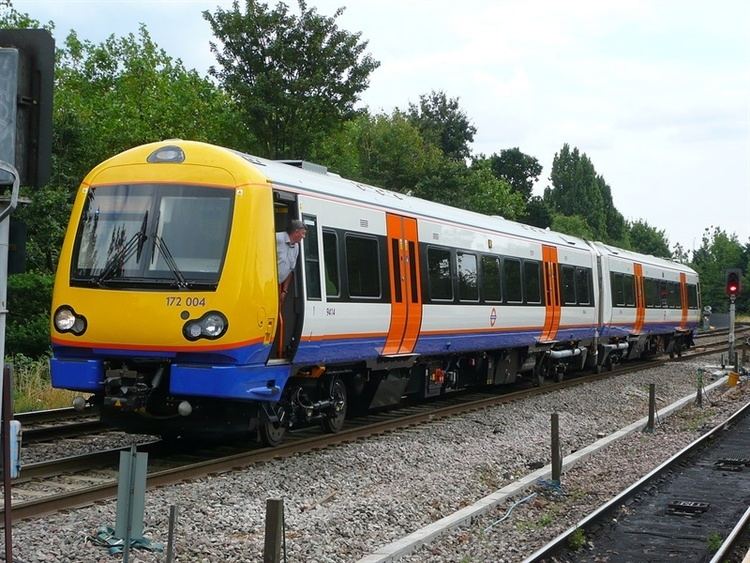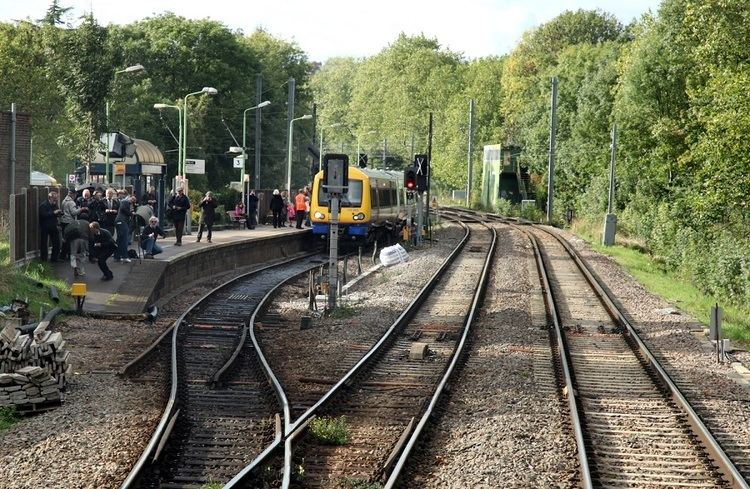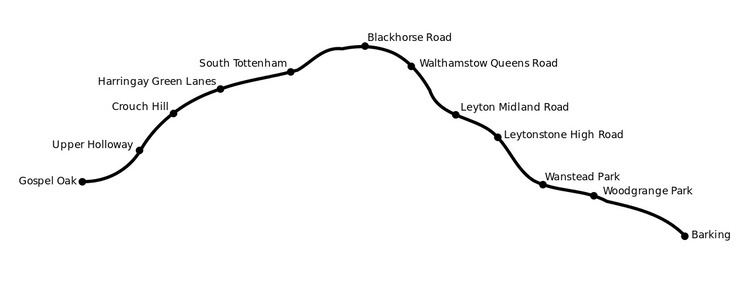Stations 12 | Status Operational Termini Gospel OakBarking | |
 | ||
Type Suburban rail and goods | ||
Willesden junction and gospel oak to barking line u k 2014
The Gospel Oak to Barking line (sometimes unofficially called the GOBLIN) is part of the Network Rail network of railway lines. It carries both through goods trains and London Overground passenger trains, connecting Gospel Oak station in north London and Barking station in east London. The line is part of Network Rail Strategic Route 6, and is classified as a London and South East Commuter line. For much of its existence the line has played a minor role in London's transport system; however, it is now receiving significant investment to increase its capacity, which will include full 25 kV AC overhead electrification, due to be completed in June 2017.
Contents
- Willesden junction and gospel oak to barking line u k 2014
- Gospel oak to barking line
- Original lines
- Predecessor routes
- Introduction of the present route
- Private operators
- London Overground
- Current operations
- Ticketing
- Passenger volume
- Trains
- Interchange
- Station facilities
- Step free access
- Controversies
- Electrification
- Longer trains
- Extension to Barking Riverside
- Thamesmead extension
- Improved interchange and new station at Junction Road
- References

Gospel oak to barking line
Original lines

The line has existed in its current form since 1981, and is mostly an amalgamation of lines built in the 19th century. The main section, between South Tottenham and Woodgrange Park, was built as the Tottenham and Forest Gate Railway, a joint project between the Midland Railway and the London, Tilbury and Southend Railway. This opened on 9 July 1894, linking the Midland and Great Eastern joint line at South Tottenham and the Forest Gate and Barking line at Woodgrange Park. The section west of South Tottenham was built as the Tottenham and Hampstead Junction Railway, which opened in 1868 but had not been commercially successful as a stand-alone railway.
Predecessor routes

Although the route between Upper Holloway and Woodgrange Park has been constant, several stations have been the ends of the line. Kentish Town, St. Pancras, Gospel Oak and Moorgate (via St Pancras) have all been the western termini. East Ham was an alternative eastern terminus for some time. Some trains were extended beyond Barking to destinations such as Southend and Tilbury. There was a regular boat train service between St Pancras and Tilbury.

A connection to Gospel Oak was added in 1888, but the routes via Kentish Town remained the primary ones and the Gospel Oak branch was abandoned in 1926. The connection to East Ham was abandoned in 1958.

The Tottenham and Hampstead Junction Railway section of the line had stations that were closed due to proximity to other stations or for other reasons. These include Highgate Road (closed 1918), Junction Road (closed 1943), Hornsey Road (closed 1943) and St Ann's Road (closed 1942).

The line was considered for closure to passengers in 1963 as part of the Beeching Axe, but as Beeching's proposals for London were not implemented for the most part, the line remained open. Even so, it was allowed to fall into a poor state of repair and reliability, and by 1980 had been cut back to an hourly service between Kentish Town and Barking. The station canopies were gradually demolished, ticket offices closed and staff withdrawn from stations.
Introduction of the present route
The situation began to improve in 1981 when electrification and upgrades to the line out of St. Pancras (later part of Thameslink) displaced the line from Kentish Town. A new link to Gospel Oak was built and the hourly service from Kentish Town was replaced by the current route from Gospel Oak with two trains per hour. The service remained very unreliable due to the age of the trains, which were initially Class 115 and 108 units, replaced in the early 1990s by class 117 and 121 units.
Private operators
Initially part of British Rail Network SouthEast, the line was privatised in 1994, the track being owned by Railtrack (subsequently Network Rail) with the passenger service provided by the North London Railways franchise. This passed to National Express in 1997, which operated the line under the brand name Silverlink until November 2007. Under Silverlink, the slam door trains were replaced by class 150 units in 2000, which improved reliability significantly. There were minor improvements in station facilities (such as CCTV and information points) but no major investment to upgrade the line and boost capacity, and the stations remained unstaffed.
London Overground
Many lines within London were running at full capacity, and as a consequence the line took on a new strategic significance as a by-pass, relieving load on other lines by allowing passengers to travel between north and east London directly.
The Railways Act 2005 abolished the franchise and gave the operation of passenger services to Transport for London (TfL). In 2005, TfL started funding a small number of additional peak time and late evening services to relieve the worst overcrowding.
TfL took full control in November 2007 introducing improved late night and weekend services, and staff, ticket machines and Oyster equipment at all stations. The frequency was increased to three trains per hour during morning and afternoon peaks and the line was included on the Tube map for the first time.
The line was closed throughout most of September 2008 for upgrade work carried out by Network Rail. Capacity was increased from six trains per hour to eight (four each for passenger and goods trains). By replacing the overbridges carrying Sussex Way and Albert Road, and lowering the track in some other locations, it was made possible for W10 loading gauge goods trains to operate. Electrification was not included.
In 2010 eight new Class 172 Turbostar diesel trains replaced the Class 150 units, with two 23-metre coaches and the option to introduce a third coach. The service frequency was increased to four trains per hour in January 2011.
Current operations
The line is owned and maintained by Network Rail as part of Great Britain's national rail network. It carries both goods and passenger traffic.
Passenger services on the line are operated by Arriva Rail London as part of the London Overground network under contract to TfL. There are four trains per hour in each direction Monday to Saturday from about 06:30 to about 2330, and on Sundays until about 22:00.
Freight services are operated by DB Cargo UK, GB Railfreight and Freightliner. The line is heavily used by freight as it provides part of an orbital route around London, connecting with many radial routes and the North London Line at Gospel Oak.
Other services that use parts of the line infrequently and as a diversionary route, but do not call intermediately are: c2c which runs a few services on the east end of the line through Woodgrange Park; London Overground also runs a service three times a week on Saturdays one between Liverpool Street and Enfield Town, one between Liverpool Street and Edmonton Green and the other between Liverpool Street and Cheshunt via Stratford and Seven Sisters. There is also a single workday morning service from Woodgrange Park to Willesden Junction, calling at all intermediate stations except for Gospel Oak.
The line has an active users' group, "The Barking - Gospel Oak Rail User Group".
Ticketing
Except at the interchange stations, staffed ticket offices were withdrawn by BR in the late 1980s. Under London Overground, self-service ticket machines were introduced in November 2007. Oyster card validators (for touching in and out) are at all stations. The ticket machines can be used to load credit onto Oyster cards. Passengers are required to buy tickets or touch in their Oyster cards, or else face a penalty fare.
Owing to the lack of ticket barriers and the difficulty of ticket verification when trains are crowded, the line has historically had a high level of fare avoidance. Under Silverlink most stations lacked any ticket purchasing facilities. In theory, passengers could purchase tickets from the conductors on the trains, but it was not always possible to do this. Following the introduction of the current ticketing arrangements, ticketless travel fell from an estimated peak of 40% under Silverlink, to 2% in March 2008.
Passenger volume
The number of paying passengers has increased very significantly since the start of London Overground.
This is the passenger volume for the years beginning April 2002 to April 2014:
Note: The large increases in the year beginning April 2006 were partly due to travelcards for National Rail journeys being made from stations that have only a London Underground office and also using a different methodology to estimate likely journeys made from National Rail stations in Zone 1. The large increases in the year beginning April 2010 were partly due to Oyster Cards being introduced in January 2010, and new rolling stock.
Trains
All trains are diesel powered as the line is not fully electrified, with only two short sections having overhead electrification, at South Tottenham, to provide a link from Seven Sisters to Stratford, and from the junction with the Great Eastern Main Line to Barking but excluding the bay platform which this service uses. These sections are used only by occasional electric trains on other routes or by goods trains.
London Overground operates eight Class 172/0 two-coach diesel multiple units (DMUs) exclusively on the line. Until 2010 the passenger train fleet consisted of six Class 150 diesel units with two coaches each.
Interchange
The line has same-station interchange with the North London Line at Gospel Oak, the Victoria line at Blackhorse Road and the Hammersmith & City line, District line and c2c at Barking. There are out-of-station interchanges at:
There are official TfL out-of-station-interchanges, whereby the passenger can continue an unbroken journey between
Two other interchanges are walkable:
Station facilities
Except at the interchange stations, station facilities are very basic. There are small shelters, information points with recorded service information, information screens and CCTV cameras. Typically there are one or two staff members on duty. Where there are no station buildings they operate out of container-sized portable offices.
Step free access
The line has some stations with step free access, allowing wheelchairs/pushchairs etc. easy access from street level to the platforms, at Gospel Oak, Upper Holloway, Harringay Green Lanes, South Tottenham, Walthamstow Queens Road and Barking.
As the trains do not align exactly with the platform height, wheelchair users will probably require assistance to board or leave them.
Controversies
Residents in Walthamstow complained that vibrations from goods traffic on the line was causing damage to their houses.
Electrification
Electrification of the line has been proposed for many years. In 2008, it was ruled out on grounds of cost and difficulty of electrifying a line with so many viaducts and bridges, but the Network Route Utilisation Strategy published by Network Rail in October 2009 showed a benefit–cost ratio for the scheme of 2.4:1. In 2012, the Mayor of London, Boris Johnson, indicated that funding was "a matter for the Department for Transport".
In 2011, Network Rail proposed electrification in Control Period 5 (CP5), but in July 2012 Justine Greening, the Secretary of State for Transport, stated that electrification was not included in the High Level Output Specification for CP5, and that any funds would need to be provided by TfL. In August, the Mayor wrote to the Secretary of State for Transport to seek a way forward, and "she committed her officials to support work with TfL, Network Rail, train operators and other industry parties to see if a viable way can be found to bridge the funding gap."
In November 2012, the magazine Modern Railways reported that the Department for Transport had ruled out the work on the basis of an estimated cost of £90 million, in contrast to an estimate of £40 million by TfL.
It was announced in June 2013 that £115 million of funding for electrification was being made available as part of upgrades to rail infrastructure included in the government's 2013 spending round. At the same time Transport for London announced that they had obtained a £90 million commitment from the Chancellor of the Exchequer and the Secretary of State for Transport.
In September 2015, Network Rail awarded the £56.9m contract to electrify the line to J. Murphy & Sons. There were part closures (at weekends and from South Tottenham to Barking) from June to late September 2016, followed by a full closure from October to February 2017. On 7 Feb 2017, Network Rail announced that whilst the line would re-open on 27 February, they weren’t able to complete all the work planned due to "incorrect" designs and late delivery of materials. Further evening and weekend works until late June 2017 were already planned, followed by around four months of commissioning work before the electric wires can be turned on so that Class 710 trains can run from early 2018.
The line will be electrified using the NR Series 2 OLE range.
Longer trains
Increases in passenger numbers have led to severe overcrowding at peak times, but it is not possible to increase peak frequencies without reducing the number of goods trains, as the line can accommodate only eight trains per hour in each direction. Any lengthening of passenger trains will require station upgrades, as some of the platforms are too short to accommodate longer trains. In 2008, works for this were planned to have been completed by 2010, but as of January 2014 were not completed. Initial plans to extend or replace the existing diesel trains with three coach diesel units were dropped following the approval of the electrification project. Instead a new fleet of 4 coach Class 710 Aventra electric units has been ordered from Bombardier.
Extension to Barking Riverside
It was announced as part of the 2014 United Kingdom budget that the Gospel Oak to Barking Line of London Overground would be extended to Barking Riverside. £263 million will be spent to extend the line to the brownfield 10,800-home Barking Riverside housing development, which Barking and Dagenham Council does not believe to be viable without improved transport connections. The developers of the site, Barking Riverside Limited, will provide £172m towards the project with the remainder coming from Transport for London. Construction will start in late 2017 and be completed by 2021.
Thamesmead extension
In addition to the plan to extend the Gospel Oak to Barking Line to Barking Riverside, there are also proposals to extend it further across the river via a future Belvedere Crossing to a station in Thamesmead, and then on Abbey Wood to connect with the future Crossrail line.
Improved interchange and new station at Junction Road
Local residents and users of the line have proposed adding a station between Leytonstone High Road and Wanstead Park to serve the Cann Hall area. The Leyton and Wanstead branch of the Labour Party has expressed an interest in the proposal. The line's user group and Islington Borough Council have been pressing for the reopening of the station at Junction Road, as its proximity to Tufnell Park tube station would allow interchange with the Northern line.
